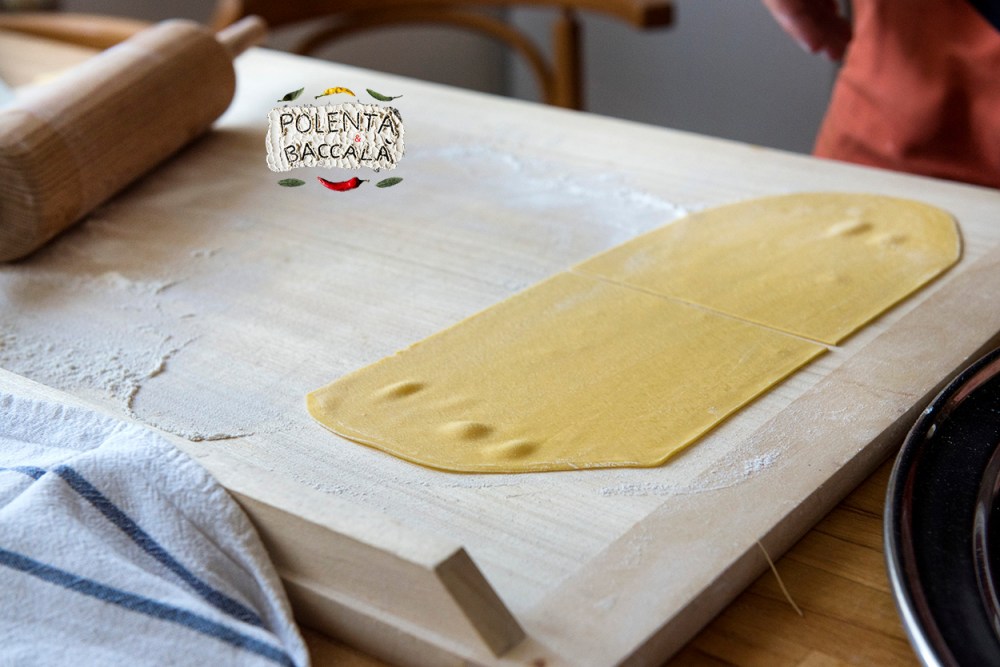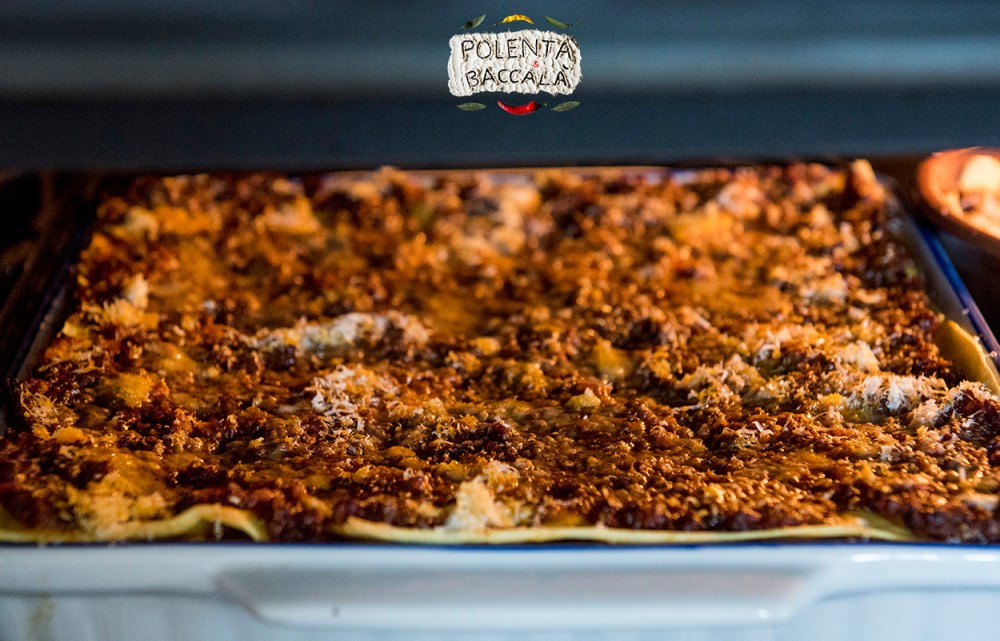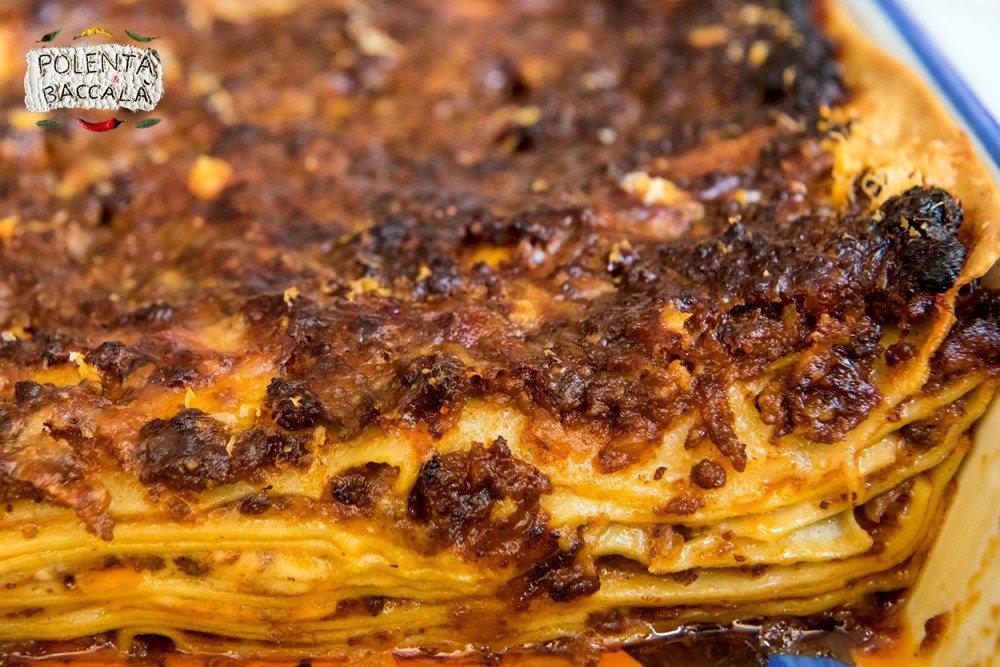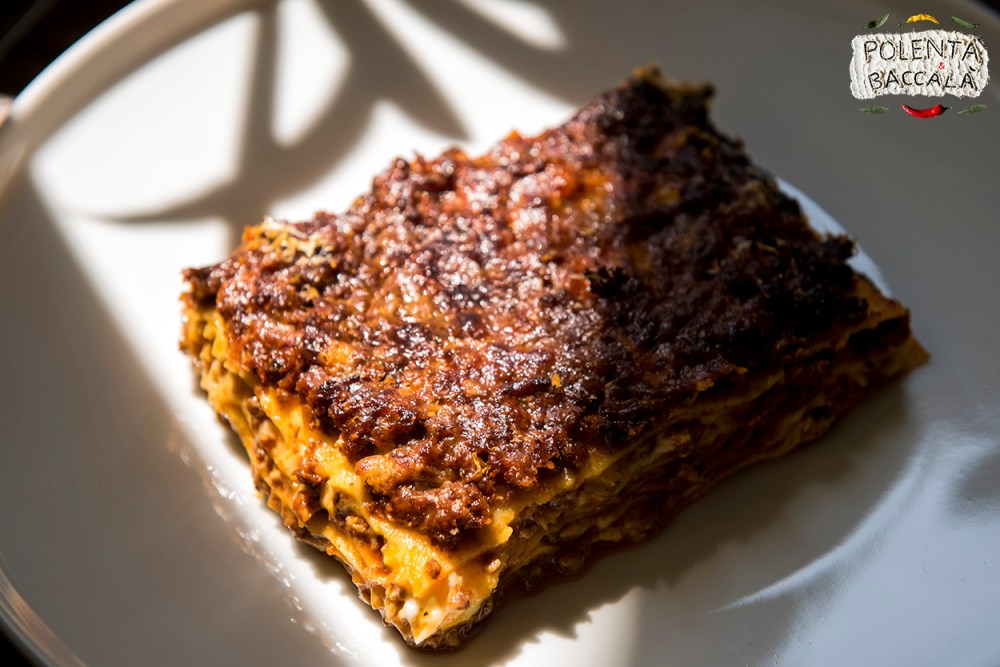
Wonderful, juicy, perfumed, fulfilling, eye-catching, opulent…there are so many adjectives to describe this worldwide famous recipe 🙂
For me it’s simply a masterpiece of the Italian tradition, definitely one of its milestones, and if we consider that at its base there is the likewise great Ragù alla Bolognese, then it couldn’t be otherwise 🙂
Already at the time of the Ancient Romans there were some kind of lasagne, called lagana and lasanea, stuffed with meat (but very probably very different from the lasagne we know, they were more like a very thin bread, baked or maybe fried). Until the Renaissance time the dough was made only with flour and water, only after appeared the first recipes where the eggs were used. More similar versions of Lasagne alla Bolognese as they are nowadays appeared in the end of the XVII century, with the pomp and grandeur of Baroque courts. But the modern recipes and its fame arrived only at the beginning of the XX century.
This is really a dish for the feasts, also because to be perfectly made it requires a lot of time, and the best suggestion is to start at least one day before, making the Ragù.
Some people suggest shortcuts, like using dry sheets of pasta bought in the stores, but this is considered an heresy in Bologna and surroundings 😀 and I agree, lasagne made with fresh homemade pasta are much better. And it doesn’t really take much longer. As I said it’s a recipe that requires a lot of time, starting from the Ragù that requires at least 3 hours to be well done, so one hour more or less it’s not a difference and it’s not justified in my opinion.
When I want to do it I do it well, or I simply do something else.
Detail: Very often you’ll see Lasagne alla Bolognese made with simple fresh pasta, but you have to know that the tradition in its place of origin actually suggests also the green fresh pasta, made using boiled spinach (but also with stinging nettle are very good) in the dough. Any other addition to the recipe, even if good (ham, salami, mozzarella, garlic, etc. let alone margarine, ketchup and other awful things I saw) it’s not provided in the traditional recipes of Emilia-Romagna region. In that case it’s simply something else (maybe very good too) but not “Lasagne alla Bolognese”, which have that specific name because of specific reasons.
The following recipe is for about 6 people if you are going to have it as a main dish, or about 8 people if you are going to have a smaller portion and you will eat also something else before or after.
INGREDIENTS (6 people):
For the Ragù alla Bolognese:
- Follow THIS RECIPE, you can reduce a bit those ingredients, about 2/3 should be enough, but if you do more than what’s needed it’s not a problem, you can also freeze it
For the fresh pasta:
- 300 g flour (sometimes I like to mix some durum flour too)
- 3 eggs
For the Béchamel sauce:
- 80 g butter
- 80 g flour
- 800 ml milk
- freshly grated nutmeg
- salt
Cheese:
- 150-200 g of freshly grated Parmigiano Reggiano
- First of all I suggest to prepare the Ragù one day before (or before, you can also freeze it), or you’ll have a lot of work to do in one day 🙂
- Then prepare the fresh pasta: sift the flour on your working table, create a “mountain” with a hole in the center, and add the eggs in that hole. Start pushing the flour in the eggs from the sides of the central hole, and then gradually adding the flour from more outside. When you have a solid mass start working it energetically, for at least 7-8 minutes long, until you have a strong, smooth and homogeneous dough.
- Cover the dough with a plastic wrap and let it rest for about 30 minutes. Then divide the dough in 4-5 smaller pieces and flatten each piece with a rolling pin. If you want you can flatten the dough in sheets of about 2 mm thick using just the rolling pin, otherwise use the manual pasta machine until the second-to-last option.
- Place the sheets over trays on which you have put some flour (better if semola rimacinata di grano duro, durum wheat semolina flour, so it will not attach to the pasta), and keep them covered with clean towels.



- When you have prepared all the pasta you have now to pre-boil it. Boil the water in a pot, add some salt and a drizzle of extra virgin olive oil, and boil the sheets of pasta for no more than 20 seconds (2-3 sheets at each time). Then put them immediately in a bowl with cold water (you can add also ice cubes), drain and place over clean towels. Drain them well.
- Now prepare the Béchamel sauce: take a pot and melt the butter at low heat, then sift the flour and add it all in one time to the butter, remove the pot from the heat and keep whisking with a manual whisker until you obtain an homogeneous blond Roux, with no lumps, and bring the pot back to the heat for a couple of minutes. Then add the milk, keep mixing, then add the salt and the grated nutmeg, and keep mixing energetically until the sauce starts to boil and becomes thicker and creamy, with no lumps at all.
- Now we have everything and we can start to assemble the lasagna 🙂 (if you have prepared the Ragù one day before remember to warm it up).

- Choose an oven pan and put on the bottom a layer of Ragù (better if you use the oil on the surface of the Ragù) and Béchamel sauce. Then place the pasta to cover all the surface: this is a tailor job 🙂 you’ll have to cut the sheets of pasta to cover well every hole. Then add another layer of Ragù mixed with Béchamel sauce and then freshly grated Parmigiano Reggiano. Repeat until you have done 5 or 6 layers of pasta (that’s what I usually do), and for last a layer made with Ragù (but without Béchamel sauce) and a generous amount of grated Parmigiano Reggiano.

- Pre-heat the oven at 180 °C, fan-assisted mode, and then bake in the middle of the oven for about 25 minutes. The last minutes switch on the Grill mode and put the pan at a higher level. It’s ready when you’ll have a nice crust on the top.

- As for the Parmigiana di Melanzane, also the Lasagne alla Bolognese taste better if they rest a bit: let them cool down at least 30 minutes, and then finally enjoy this great dish! 🙂
- If something remains it’s not a problem, the day after it’s even better 🙂





Your lasagna looks great! We love them as well! However, I still haven’t found courage to prepare my own sheets ☺️
LikeLiked by 1 person
Thank you 🙂 Come on, it’s not that difficult 🙂 once you learn you will never do without, trust me 🙂
LikeLiked by 1 person
I really should start! 😌 it doesn’t look difficult and I am sure that homemade ones are the best! 😍 And we really love lasagne!!! Last time I made vegetables one only.
LikeLiked by 1 person
These are the famous “Lasagne alla Bolognese”, made with the traditional “Ragù alla Bolognese”, but there are a lot of other good recipes with this pasta 🙂 for example in Sardinia I had the opportunity to eat a local recipe made with tuna and pesto, it was very good. But there are with vegetables, fish, other meat, etc.
LikeLiked by 1 person
What a treat to see this classic recipe made as it should be. I’ll definitely be trying this version. Just looks so delicious.
LikeLiked by 1 person
Thank you 🙂
LikeLike
How interesting to learn about the tuna and pesto lasagne in Sardinia. I have a friend in Trentino who gave me his recipe that included rosemary in the bechamel.
LikeLiked by 1 person
It was in Carloforte to be more precise. It’s an island that in the past was colonized by people with origins from Genoa republic, that’s why the pesto. They also speak a ligurian dialect there and not from Sardinia 🙂 and also the only place in Italy where the last “tonnara” still works.
LikeLike